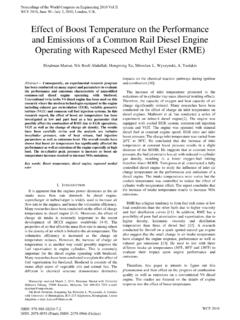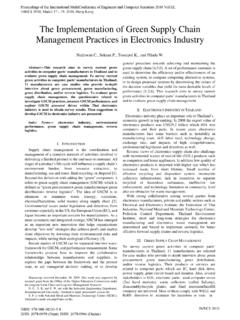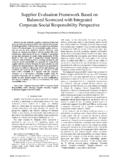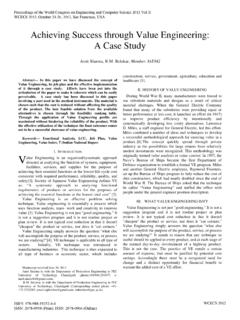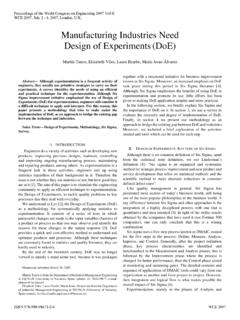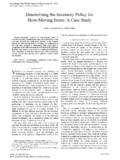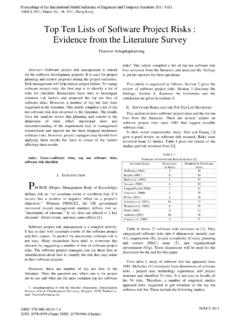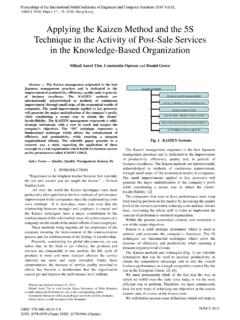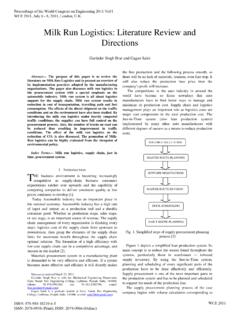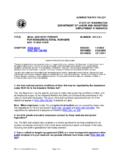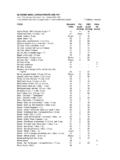Transcription of Laboratory Procedures for Assessing Quality of …
1 Abstract Protein Quality of soybean meal (SBM) is linked to both the reduction of anti-nutritional factors (ANFs), and the optimization of protein digestibility. Inadequate heating fails to completely destroy the ANFs. Excessive heating reduces the availability of lysine via the Maillard reaction and possibly, to a lesser extent, other amino acids, and decreases the protein nutritive Quality . The objective of the study was the analysis of some chemical indices for determining SBM Quality , and their correlation with biophysical indices. The experimental data revealed that urease index (UI) is useful to determine if the soybean meal has been heated enough to reduce ANFs, but it is not useful to determine excessive heat treatment. KOH solubility is a good index for determining over processing, but it is not a sensitive index for monitoring under processing of soybean meal. Combing protein dispersibility index (PDI) and UI could be useful to monitor soybean Quality .
2 The investigated biophysical indices are positively correlated with PDI: r = (p< ) for refractive index, and r= (p< ) for dynamic viscosity. The biophysical methods have the advantage to be very rapid and nonpolluting since they don t use chemical reagents. Index Terms soybean meal, urease index, protein solubility, refractive index, dynamic viscosity. I. INTRODUCTION Today soybeans (Glycine max) are grown primarily for the production of vegetable oil for human consumption but, as a by-product, soybean meal (SBM) is becoming increasingly important. soybean is the only vegetable food that contains complete protein, meaning all of the eight amino acids needed for human and animal health are present. Among plant protein sources, SBM has a high level of tryptophan and Manuscript received July 24, 2010. This work was supported by CNCSIS UEFISCSU, project number 1054/2009 PNII IDEI code 894/2008 and by project number 1055/2009 PNII IDEI code 898/2008.
3 Rodica Caprita is with the Department of Exact Sciences, Banat University of Agricultural Sciences and Veterinary Medicine Timisoara, Calea Aradului 119, 300645 Timisoara, Romania (corresponding author, phone: 0040256277298; fax: 0040256200296; e-mail: @ ). Adrian Caprita is with the Department of Chemistry, Banat University of Agricultural Sciences and Veterinary Medicine Timisoara, Calea Aradului 119, 300645 Timisoara, Romania (e-mail: @ ). Gheorghe Ilia is with the Institute of Chemistry Timisoara of Romanian Academy, Bd. Mihai Viteazul 24, 300223 Timisoara, Romania (e-mail: Iuliana Cretescu is with the Department of Exact Sciences, Banat University of Agricultural Sciences and Veterinary Medicine Timisoara, Calea Aradului 119, 300645 Timisoara, Romania (e-mail: @ ). Vasile Octavian Simulescu is with the Institute of Chemistry Timisoara of Romanian Academy, Bd. Mihai Viteazul 24, 300223 Timisoara, Romania (e-mail: the highest digestible lysine content which complements the lysine deficiency of cereal grains used in animal feeds.))
4 The anti-nutritional factors (ANFs) in soybean are often associated with the low acceptance of soybean products as they also inhibit protein digestibility. These mainly consist of heat labile (trypsin inhibitors, lectins, goitrogens, phytates) and heat stable (oligosaccharides) factors. In order for the nutritional value of soybean meal to be maximised, these anti-nutritional factors need to be inactivated or minimised [1]-[3]. Most SMB is produced today by the solvent extraction process whereby the soybeans are cracked, heated and flaked before the oil is extracted with the solvent hexane. Once the oil has been removed, the flakes are toasted and ground into meal. During this production process, temperature is critical in order to deactivate the anti-nutritional factors naturally present in raw soybeans. The challenge in SBM processing is to apply the optimum amount of heat to produce the most nutritious product.
5 While mild heating (~ 90oC) improves the nutritional value of SBM by denaturing the proteins and exposing new sites for enzymatic hydrolysis as well as inactivating heat labile ANFs, excessive heating reduces the availability of lysine (via the Maillard reaction) and possibly, to a lesser extent, other amino acids [4], [5], lowering the nutritive value of SBM. Both insufficient and over heating result in poor Quality SBM. Therefore, feed manufacturers require methods to distinguish adequately processed SBM from under or over processed meals . An important and frequently observed effect of food processing is the reduction of protein nutritive Quality . The denaturation of the protein and reduction in amino acid availability by cross-linking, racemization, degradation and formation of complexes with sugar may result in loss of digestibility [4], [6], [7]. Therefore, when attempting to estimate protein Quality , one of the first factors that must be evaluated is its digestibility [8], [9].
6 Protein Quality of SBM depends on two parameters: the reduction of anti-nutritional factors and the optimization of protein digestibility [10]. Direct analysis of both specifications is difficult in routine operations. It is therefore replaced with indirect tests such as urease index (UI), Protein Dispersibility Index (PDI), Nitrogen Solubility Index (NSI) and KOH protein solubility (PS). SBM processors and their customers in the animal feed industry need reliable, rapid and cost-efficient methods to control the Quality of their soybean meal. Therefore, the goal of this research was to compare some chemical and biophysical Laboratory Procedures for Assessing SBM Quality , and to establish the most suitable for evaluating under and over processing. Laboratory Procedures for Assessing Quality of soybean Meal Rodica Caprita, Adrian Caprita, Gheorghe Ilia, Iuliana Cretescu, and Vasile Octavian Simulescu Proceedings of the World Congress on Engineering and Computer Science 2010 Vol II WCECS 2010, October 20-22, 2010, San Francisco, USAISBN: 978-988-18210-0-3 ISSN: 2078-0958 (Print); ISSN: 2078-0966 (Online)WCECS 2010 II.
7 EXPERIMENTAL Reagents All chemicals used were of analytical reagent grade. Doubly distilled deionized water was used for all experiments. Phosphate buffer solution ( M phosphate buffer): g of monobasic potassium phosphate (Merck) were dissolved in approximately 100 mL of distilled water. g of dibasic potassium phosphate (Merck) were dissolved in approximately 100 mL of distilled water. The two solutions were combined and diluted to 1000 mL. Solutions were mixed using stir bar and stir plate. Buffered urea solution: 15 g of urea (Merck) were dissolved in 500 mL of the phosphate buffer solution. 5 mL of toluene (Merck) were added to serve as a preservative and to prevent mold formation. Solutions were mixed using stir bar and stir plate. Biuret reagent: g of copper (II) sulfate (Merck) were dissolved in 250 mL of distilled water. of sodium potassium tartrate (Merck) and g of potassium iodide (Merck) were added.
8 After solids have dissolved, 50 mL of M NaOH (Merck) were added and diluted to a total volume of 500 mL with distilled water. Apparatus Spectrophotometric measurements were performed using a PerkinElmer UV/VIS-Lambda35 spectrophotometer. A Consort C861apparatus was used for pH measurement. Stirring was carried out by a Barnstead SP135930-33 magnetic stirrer. Heating at 120 C was performed in an air forced oven Froilabo AC60. Samples were centrifuged with a Hettich 320R centrifuge. Crude protein of SBM was determined using a Kjeltec Foss Analyser Unit. Refractive indices were measured with a refractometer Kr ss DR301-95. Dynamic viscosity was measured using a cone/plate viscometer Brookfield Model DVIII Cone CP-40. A Kern ABJ 220-4M balance was also used. Procedures Raw and toasted commercial SBM were used for the experiment. The samples were ground to pass the 200 sieve.
9 SBM samples were heated in a forced air oven at 120 C for varying periods of time: 5, 10, 15, 20, 25 and 30 minutes. Crude protein of SBM was determined by the Kjeldahl method [11]. The urease assay is based on the pH increase from ammonia released from urea by residual urease enzyme in SBM [12]. The urease test was conducted as following: 10 cm3 buffered urea solution (pH= ) was added to g finely ground SBM (test sample), and 10 cm3 phosphate buffered solution was added to g of the same sample (blank sample). The two solutions were incubated at 30 C for 30 minutes under stirring. In the presence of significant urease activity the pH of the test solution increases due to the release of ammonia from urea. After incubation, the pH of the solutions are determined rapidly and the difference between pH of test and pH of blank is calculated as an index of urease activity. The protein solubility was determined according to the procedure of Araba and Dale [8].
10 The KOH protein solubility test is based on the solubility of soybean proteins in a dilute solution of potassium hydroxide. The procedure involves incubation of g sample with 75 mL KOH (wt/vol; N) solution for 20 min at room temperature using a magnetic stirrer. Following this incubation, the sample is centrifuged for 5 minutes at 6,000 rpm and the supernatant is analyzed for the protein concentration by the biuret method. The solubility of the protein, expressed as a percentage, was calculated by dividing the protein content of the KOH-extracted solution by the protein content of the original soybean sample ( ). The Protein Dispersibility Index assay is also based on the solubility of soybean protein [13]. For this test the solvent is water. The PDI method uses ten minutes of high speed mixing in distilled water at 8,500 rpm [14]. Nitrogen Solubility Index uses a slow stirring technique.
